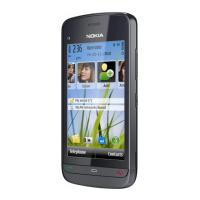
Do you have a question about the Nokia C5-03 and is the answer not in the manual?
| Display | TFT resistive touchscreen, 16M colors |
|---|---|
| Resolution | 360 x 640 pixels, 3.2 inches (~229 ppi pixel density) |
| Operating System | Symbian OS v9.4, Series 60 rel. 5 |
| Processor | 600 MHz ARM 11 |
| RAM | 128 MB |
| Main Camera | 5 MP |
| Video | 480p@15fps |
| Battery | Removable Li-Ion 1000 mAh battery (BL-4U) |
| Talk time | Up to 11 h 30 min (2G) / Up to 4 h 30 min (3G) |
| Music play | Up to 35 h |
| Dimensions | 105.8 x 51 x 13.8 mm, 65 cc (4.17 x 2.01 x 0.54 in) |
| Weight | 93 g (3.28 oz) |
| Network | GSM / HSPA |
| 2G bands | GSM 850 / 900 / 1800 / 1900 |
| GPRS | Class 32 |
| EDGE | Class 32 |
| Announced | 2010, October |
| Status | Discontinued |
| SIM | Mini-SIM |
| GPU | No |
| Card slot | microSD, up to 16 GB (dedicated slot), 2 GB included |
| Alert types | Vibration; MP3, WAV ringtones |
| Loudspeaker | Yes |
| 3.5mm jack | Yes |
| WLAN | Wi-Fi 802.11 b/g |
| Bluetooth | 2.0, A2DP |
| Radio | Stereo FM radio, RDS |
| USB | microUSB 2.0 |
| Sensors | Accelerometer, proximity |
| Browser | WAP 2.0/xHTML, HTML, Adobe Flash Lite |
| Java | Yes, MIDP 2.1 |
| Internal Storage | 40 MB |
| Stand-by | Up to 576 h (3G) |
| 3G bands | HSDPA 900 / 2100 |
| GPS | Yes, with A-GPS |
| Colors | Black, Pink |
Procedures for safely removing the battery from the device.
Accessing instructions and help directly on the device for applications.
How to get support and resolve issues with the device.
Step-by-step guide to inserting the SIM card and battery.
Instructions on how to charge the device's battery.
Identification and description of the device's physical keys and components.
Procedure for powering on the device for the first time.
Initial setup of the device, including regional settings and accounts.
Explanation of icons and indicators on the device screen for status.
How to use the device without a cellular network connection.
How to make and end phone calls using the device.
Methods for answering or rejecting incoming calls on the device.
Using voice commands to make calls to contacts.
Using the on-screen virtual keyboard for text input.
Inputting text by writing characters on the screen.
Adding and modifying contact information in the device.
Setting default phone numbers and addresses for contacts.
Copying contact information between SIM card and device memory.
Navigating the main messaging interface and folders.
Creating and sending text or multimedia messages.
Configuring e-mail accounts on the device for sending and receiving mail.
Managing contacts and staying connected through the Ovi community.
Adjusting device settings for login, tones, and icons.
Customizing the device's appearance using themes and wallpaper.
Playing music files and podcasts on the device.
Transferring music files from a computer to the device.
Launching the camera application on the device.
Taking still photographs using the device's camera.
Adding GPS location data to captured photos and videos.
Browsing and organising images, videos, and sound clips.
Downloading and watching video clips from online services.
Copying video clips from a computer to the device.
Accessing and navigating web pages using the device's browser.
Saving and accessing favourite web pages for quick access.
Introduction to the Maps application and its features.
Viewing current location and navigating the map interface.
Searching for specific locations and businesses on the map.
Using voice instructions for navigation while driving or walking.
Understanding and configuring data connections and access points.
Managing network modes and operator selection for cellular connectivity.
Connecting to wireless local area networks (WLAN).
Establishing wireless connections with other Bluetooth-enabled devices.
Setting time, date, and alarms using the Clock application.
Managing appointments, meetings, and to-do notes with the Calendar.
Browsing, managing, and opening files on the device.
Managing installed applications, including installation and removal.
Configuring general phone settings like date, time, and language.
Managing security features like PIN codes, lock codes, and SIM card settings.
Tips for extending battery life and conserving energy.
Important safety guidelines for handling and using the device battery.
Precautions regarding potential interference with medical devices.